Introduction
AMD has been having great success with their HD 5xxx line. These GPUs are not only the only DX11 parts on the market at the moment, but have performance that out does just about every offering from NVIDIA. However, they have not been doing overly well in the chipset and CPU market. Here they have been outdone by Intel consistently over the last few years.
This has been good for Intel, but bad for the market in general. Of course, AMD has made some great strides in the CPU realm and in fact have produced some good and inexpensive products that have quite a bit of room for overclocking. Now they are moving back to the chipset side and are launching a new chipset today, the 890GX.
This chipset brings the first SATA 3.0 only motherboard to the market. This is in stark contrast to the Marvell driven offerings from Intel. AMD's 890GX is also the first board to use all PCIe 2.0 lanes for increased (and proper) bandwidth to its peripherals.
So let's take a look at the AMD 890GX in the form of the ASUS M4A89GTD Pro/USB3 motherboard.
What's new with the 890GX
As we mentioned in our intro, the 890GX is a brand new game. Unlike the PCIe 1.0 limited P55 and H55, the 890GX has shifted to all PCIe 2.0 lanes.
This means that each lane has twice the bandwidth (500MB/s vs. 250MB/s) that the Intel chipsets offer (or at least the P55 and H5x ones). This gives the 890GX much more headroom and has allowed AMD to implement SATA 3.0 in the Southbridge and a wider and more efficient path to the USB 3.0 controller, too.
This is going to give AMD an advantage over Intel's P55 and H5x chipsets in terms of SATA 3.0 and USB 3.0 performance. This is even when compared to solutions like the ones that ASUS and GIGABYTE are using (with a bridge chip providing the extra lanes).
A New IGP
But the use of all PCIe 2.0 lanes and SATA 3.0 ports are not the only new things. AMD has also stuffed in a new and more powerful IGP; this is the 4290. The 4290 has a cluster of 40 unified shaders, a 700MHz clock speed and a 64/128-bit memory interface.
The HD 4290 also has some exciting features for the HTPC and mainstream market. For the HTPC crowd you will be happy to know that the HD 4290 includes hardware accelerated up scaling, Stream accelerated transcoding, AVIVO and real time color correction. It also has support for Blu-ray 1.1 features and DX10.1.
The last of the above features is a little interesting given AMD's push for DX11. Still, considering there is not another IGP out with full DX11 support, AMD does seem to be in a good position with the HD 4290.
Some old friends
But with the new there are some old friends that you have come to know and love from AMD chipsets. There is the popular core unlocking feature that has allowed more than one tri and even dual core owner to become a full-fledged quad owner. The AM3 socket brings DDR3 support and allows you to use just about any of the AMD CPUs on the market. Hybrid Crossfire and AMD Overdrive slip in there, too.
The Packaging
Box and Contents
AMD provided us with an ASUS M4A89GTD Pro/USB3 for our 890GX testing. This board has more than a few nice features. Let's take a look at them now.
As with all of the new "Pro" boards from ASUS, we find the box to be an interesting contrast.
The light green color is for AMD (as the blue is for Intel). We still have to deal with the large "medallion" on the front, but there are some nice logos to get our attention on the front of the box. The biggest one is the Core Unlocking ability. The handy feature allows some tri-core and even dual core Phenom II and Athlon II owners to open up additional cores on their CPUs.
The back of the box goes into a little more detail about the major features and even provides a detailed image of the board and what you get with it
Inside the box is the usual compliment of goodies with two interesting exceptions. The first is a card and the second is a pair of SATA 3.0 cables.
The SATA 3.0 cables look almost exactly like a typical SATA II cable with the exception of the split and the white plastic "label" on them. They almost look like some of the early SAS cables I have seen, without the power and extra three pins that is.
The included card is odd and says it is needed for full x16 single card mode. What is odd is that it says you need to put this in the "black" PCIe x16 slot, but as you will see below there is no black slot on the board.
However, if you check the manual it does explain which slot they mean; it is the top x16 slot (the grey one). This is only needed to get full x16 performance from the lower blue slot, but even without the card in place the slot will work, but it will just be limited to x8.
The Motherboard
The 890GX follows the same lines as every other ATX board out these days. However, unlike the P55 and H5x boards the AMD 890GX still has both the Northbridge and Southbridge (as does the X58 boards). This means that ASUS has had to wisely configure the layout for the best balance of cooling and performance.
Starting from our usual place, we see a couple of departures from (and additions to) the AMD layout. The first one that leaps out at you is the RAM slots which look reversed from what we have gotten used to. On most of the ASUS boards we have worked with the lever is at the top and the open end at the bottom. On the M4A89GTD Pro/USB3 this is swapped.
In noticing that brings us to a couple of new items on the M4A89GTD. These are the Core Unlocker switch and the Turbo Key II switch. The turning on the core unlocker switch allows you to automatically unlock your tri-core or dual core CPU without needing to make adjustments in the BIOS.
The area around the CPU is a tad cluttered, but nothing that cannot be overcome. One thing that I like (although it looks awkward) is the new extended 8-pin Aux power connector. As you have heard in multiple reviews, we have criticized most manufacturers about their placement of this connector, but have noted that it is there due to restrictions of the ATX layout and design.
Well, ASUS has decided to do something about it anyway. They extended the connector to a height above the surrounding heatsinks. This should make it a little easier to connect once it is in a case. However, even with this new height, you may still have trouble if you use an oversized cooler for the CPU.
As we mentioned before, AMD still uses two chips for the motherboard designs. This is not a hindrance to performance, but it can be to motherboard real-estate. As you see in the image below, the Northbridge is very close to the top PCIe x16 slot. Thankfully it is far enough away that you do not have to worry about contact, but you still need to be concerned with heat.
Moving to the bottom of the board, we again see the typical layout and nothing much that is overly new. You get tons of USB headers, IEEE 1394 and the ever popular front panel audio header along with a nice assortment of PCIe and PCI slots.
However, when we move to the SATA ports we see another departure from ASUS' normal layout. Instead of six ports at a 90-degree angle, we find only two in this configuration. The remaining four are spaced out and extend perpendicular to the board.
The ports available on the back are again fairly typical now, with the exception of the USB 3.0 ports (and those are becoming common).
Overall, the ASUS M4AGTD Pro/USB3 is laid out fairly well. There are some interesting changes and departures from the normal layout, but that is not to be unexpected as ASUS (and others) try to overcome the limitations of the ATX layout and the ever increasing need for additional power to the motherboard and CPU.
BIOS and Overclocking
BIOS
As with every other ASUS motherboard, the M4A89GTD Pro/USB3 uses a AMI based BIOS. Of course, ASUS has altered it to allow for what they feel is the best performance and the most flexibility for user configuration.
For most people the AI Tweaker menu is the place to be. Here you can adjust settings that will give you the most out of your AMD CPU. You can also make adjustments to the HD 4290 IGP. These include adjusting the GPU speed and the amount of memory used in addition to the Sideport memory. You can also use the ASUS Level Up API and Overclock Tuner straight from inside the BIOS, which is handy if you are not using a Windows based OS with your board.
Under the CPU menu on the Advanced page you can see the information about your CPU. We used a revision C2 Phenom II x4 955. This would become a problem for us later when we pushed the board. You also have options for enabling or disabling Cool' n' Quiet, Core Unlocker, C1E support and a few other CPU features.
Moving on to the memory configuration page (still on the Advanced menu), you have settings that allow you to control bank interleaving, memory remapping; pretty much the advanced items that most people are better off not messing with.
The same thing can be said for the Integrated Graphics page. Many of these settings can give you minor boosts in performance and stability, but if you tinker in the wrong direction you could end up with issues. One of the few items that is nice to see is the ability to turn off the audio out to HDMI from the BIOS. The rest of the BIOS has some additional handy features, like Express Gate settings and for the most part is very easy to navigate.
Overclocking
In the past our experience with ASUS and overclocking has been a good one. That is not to say it has always given us the best overclock or the best performance when overclocked, but we have been able to get some very decent numbers from their stuff.
With the M4A89GTD Pro/USB3 we had a few issues. At first we thought there was an issue with the way the board was handling memory, but in the end we found out that it was all due to our choice of CPU. The AMD Phenom II X4 955 is a good CPU, but it did not like to be pushed too hard.
As we mentioned above in our BIOS section, we have a C2 revision of this CPU. When we spoke with ASUS about the problems we were having we were told that a C3 revision would yield better results. Unfortunately we were not able to get one before this article needed to be published. However, we will be returning to this board to see what we can get with the newer C3 stepping CPUs as well as doing some IGP overclocking.
With our C2 Phenom II X4 955 we were able to hit a stable high of 3.642MHz (227x16). We could not get anything higher even when playing with the multipliers or the HTT.
You can see the validation for our overclocking here.
Something interesting to note; in the CPU-Z shot above it shows the HD 4290 as DX11. We contacted AMD about this as we were told that the 4290 was DX10.1 only; they let us know that this is an error on the part of CPU-Z and not accurate. We expect this discrepancy to be fixed with the next release of CPU-Z.
Of course, we would be remiss if we did not touch on the TurboV application that ASUS has included. But again, as our CPU was a bottle neck we will go into more detail about this later. For now we will show you the outcome of our fast auto tune and the core ratio settings page, both of which are unique to the AMD based 890GX boar from ASUS.

As all overclocking results are dependent on the hardware you use, your results may vary. Results of our overclocking tests are included in the performance section with the stock scores.
Important Editor Note: Our maximum overclocking result is the best result we managed in our limited time of testing the motherboard. Due to time constraints we weren't able to tweak the motherboard to the absolute maximum and find the highest possible FSB, as this could take days to find properly. We do however spend at least a few hours overclocking every motherboard to try and find the highest possible overclock in that time frame. You may or may not be able to overclock higher if you spend more time tweaking or as new BIOS updates are released. "Burn-in" time might also come into play if you believe in that.
Test System Setup and Comments
Test System
Processor: AMD Phenom II X4 955 (C2 Stepping)
Mainboard ASUS M4A89GTD Pro/USB3 (Supplied by ASUS)
Memory: 4GB Kingston KHX12800D3T1K3/6GX (Supplied by Kingston)
Hard Disk: Kingston SSD Now M (Intel X25-M 80GB SSD) (Supplied by Kingston)
Graphics Card: AMD Radeon HD 5870 1GB (Supplied by AMD)
Cooling: Cooler Master Hyper 212 (with an extra fan) (Supplied by Cooler Master)
Operating System: Microsoft Windows 7 Ultimate x64
Drivers: AMD Catalyst 10.3
Comments
As we mentioned earlier, ASUS has used a new connector for the 8-pin aux power. When I first saw it I thought it would be unstable and wobbly, but in use it seemed very solid and easy to use. The reversed RAM slots also seemed to be a bad idea at first, but once again, in practice they may work out better. In some cases it is hard to reach the upper portions of the board, making it a little awkward to uninstall RAM. But with the way the slots and the first PCIe slot are arranged on the M4A90GTD Pro/USB3 you have plenty of room to get your fingers in there.
The SATA ports were another interesting departure that also works out quite well. After all, there are an increasing number of cases that have the HDDs in cages that are 90-drgrees from the motherboard backplane. These new ports will be easier to use with that type of case in mind.
The included SATA 3.0 cables were sort of funny. Although they are very clearly higher quality cables, they offered no noticeable performance gain over the standard ones when connected to a SATA 3.0 HDD.
Last up in our comments is that card we told you about in our Packaging and Contents section. It was an interesting item to see and reminded me of the old SLI bridges that needed to be used. However, we did find that you can run the M4A89GTD Pro/USB3 without it. True, you do drop down to x8 on the PCIe slot, but the performance hit was so small as to be unnoticeable with the HD5870 we used for testing. Still, if you throw a HD5970 on to this board we are sure you would want to have it safely plugged in. Just put it in the top "grey" slot and ignore what it says on the card.
Synthetic Tests - Part I
With any system you will want to see a combination of synthetic testing and real-world. Synthetics give you a static, easily repeatable testing method that can be compared across multiple platforms. For our synthetic tests we use Everest Ultimate, Sisoft Sandra, Futuremark's 3DMark Vantage and PCMark Vantage, Cinebench as well as HyperPi. Each of these covers a different aspect of performance or a different angle of a certain type of performance.
Memory Bandwidth
Memory is a big part of current system performance. In most systems slow or flakey memory performance will impact almost every type of application you run. To test memory we use a combination of Sisoft Sandra, Everest and HyperPi 0.99.
Sisoft Sandra
Version and / or Patch Used: 2010c 1626
Developer Homepage: http://www.sisoftware.net
Product Homepage: http://www.sisoftware.net
Buy It Here
It used to be a fact that AMD had better memory performance. The M4A89GTD Pro maintains this trend by outperforming the Core i5 661 on the ASUS P7H57D-V EVO.
Everest Ultimate
Version and / or Patch Used: 5.30.1983
Developer Homepage: http://www.lavalys.com
Product Homepage: http://www.lavalys.com
Buy It Here
Everest Ultimate is a suite of tests and utilities that can be used for system diagnostics and testing. For our purposes here we use their memory bandwidth test and see what the theoretical performance is.

Stock Memory Performance

Overclocked Memory Performance

With Radeon HD 5870
HyperPi 0.99
Version and / or Patch Used: 0.99
Developer Homepage: www.virgilioborges.com.br
Product Homepage: www.virgilioborges.com.br
Download It Here
HyperPi is a front end for SuperPi that allows for multiple concurrent instances of SuperPi to be run on each core recognized by the system. It is very dependent on CPU to memory to HDD speed. The faster these components, the faster it is able to figure out the number Pi to the selected length.
For our testing we use the 32M run. This means that each of the four physical and four logical cores for the i7 and the four physical cores of the i5 is trying to calculate the number Pi out to 32 million decimal places. Each "run" is a comparative to ensure accuracy and any stability or performance issues in the loop mentioned above will cause errors in calculation.
Unfortunately the AMD CPUs are not able to match the computational power of the Intel CPUs. As you can see in HyperPi, even the dual core i5 661 can outperform the similarly clocked 955 which is a native quad core CPU.
Synthetic Tests - Part II
Disk Drive Controller
The system drive controller is an important part of system performance. In most modern boards your drive controller will run off of the PCI-e bus. The PCI-e bus performance can be affected by poor trace layout as well as many other design choices that show up on different boards.
For testing we use Sisoft's Sandra and Everest.
SiSoft Sandra
Despite being a full SATA 3.0 controller, we see SATA II performance that is slightly behind the Intel controllers. SATA 3.0 performance is right where it should be, as is USB 3.0 performance.
Everest
Stock HDD Performance
Overclocked HDD Performance
Stock USB 3.0 Performance
Overclocked USB 3.0 Performance
Everest Ultimate confirms our Sandra results and shows that while the SATA 3.0 performance is spot on, SATA II drives will suffer a little on the AMD SB850.
Synthetic Tests - Part III
Here is where we dig out the FutureMark tests.
PCMark Vantage
Version and / or Patch Used: 1.0.0.0
Developer Homepage: http://www.futuremark.com/
Product Homepage: www.futuremark.com
Buy It Here
Although we know that a synthetic is not a real measure of a boards performance, it is still not good to see the Intel system perform so well, even against the overclocked 955.
3DMark Vantage
Version and / or Patch Used: 1.0.1
Developer Homepage: http://www.futuremark.com/
Product Homepage: www.futuremark.com
Buy It Here
For synthetic gaming tests we used the industry standard and overlockers bragging tool 3DMark Vantage. This is a test that strives to mimic the impact modern games have on a system. Futuremark went a long way to change from the early days of graphics driven tests to a broader approach including physics, AI and more advanced graphics simulations. 3DMark Vantage uses the DX10 API in addition to having support for PhysX. Due to the PhysX support and our use of an NVIDIA GPU, we run with PhysX enabled and disabled to give you the best indication of real system performance. For testing we use the Performance test run.

Interestingly the HD GMA on the Core i5 661 manages a better 3DMark score than the better spec'ed HD 4290.
Cinebench R10 x64
Version and / or Patch Used: R10
Developer Homepage: http://www.maxon.net/
Product Homepage: www.maxon.net
Download It Here
Cinebench is a synthetic rendering tool developed by Maxon. Maxon is the same company that developed Cinema4D, another industry leading 3D Animation application. Cinebench R10 tests your systems ability to render across a single and multiple CPU cores. It also tests your systems ability to process OpenGL information. This will be our last evaluation with the now discontinued benchmark. We only include it here for comparison purposes.

Here the native Quad Core Phenom II X4 955 shows its muscle and outdoes the dual CPU (with HyperThreading) Core i5 661 and H57 board.
Cinebench R11.5 x64
Version and / or Patch Used: R11.5
Developer Homepage: http://www.maxon.net/
Product Homepage: www.maxon.net
Download It Here
Cinebench is a synthetic rendering tool developed by Maxon. Maxon is the same company that developed Cinema4D, another industry leading 3D Animation application. Cinebench R10 tests your systems ability to render across a single and multiple CPU cores. It also tests your systems ability to process OpenGL information. We are currently in a transition phase to move to the new R11.5 version of Cinebench. This software improves both the GPU based OpenGL rendering test and the CPU based image render. It provides a much better test for multi-core, multi-threaded CPUs and once again changes the scoring routine.

Although this is the first run of this test, we still see numbers that are a fairly good.
Real-World Tests - Part I
Real-world testing allows us to see how well a product will perform when used in the same manner as it would be in your house or office. It is an important side to performance testing as it can uncover hidden glitches in the way a product performs.
It is especially true when testing a mainboard; there are so many components of a board that have to interact that any problems between parts can cause a failure of the whole.
For real-world testing we use some common applications and functions. We test with LightWave 3D for rendering performance, AutoGK for transcoding from DVD to AVI and two games for gaming testing.
Rendering
Rendering of 3D Animation is a system intensive endeavor. You need a good CPU, memory and HDD speed to get good rendering times. For our testing we use LightWave 3D. This software from Newtek is an industry standard and has several pre-loaded scenes for us to use.
LightWave 3D
Version and / or Patch Used: 9.6
Developer Homepage: http://www.newtek.com
Product Homepage: http://www.newtek.com/lightwave/
Buy It Here
Also starting with this review we are going to be pushing forward with using newer LightWave scenes that make use of Raytracing. We will also be pushing up to a higher 4k resolution (4096x3072). These two extra features will place en even greater burden on the CPU and system. If there is anything not up to par, we will see it right away here.
With a time of 36 minutes we see that the addition of Ray Tracing and 4k resolutions have put a much larger stress on the 955. This is unfortunately higher than we would have liked to see.
AutoGK
Version and / or Patch Used: 2.55
Developer Homepage: http://www.autogk.me.uk/
Product Homepage: http://www.autogk.me.uk/
Download It Here
AutoGK stands for Auto Gordian Knot; it is a suite of transcoding tools that are compiled into an easy to install and use utility. It allows you to transcode non-protected DVDs and other media to Xvid or Divx format. For our testing purposes we use a non-DRM restricted movie that is roughly 2 hours in length. This is transcoded to a single Xvid AVI at 100% quality.
Again our transcoding times are not where they should be. However, I do not think that is a board issue, but more a problem with the CPU. We will be checking this in future evaluations.
Real-World Tests - Part II
Here we have our real gaming tests. Each of the games we chose use multiple cores and GPUs. They are able to stress the system through use of good AI. Both have decent positional audio that adds impact to the sound subsystem of the board. We ran each game through the level or parts listed and recorded frames per second using FRAPS. This brings the whole game into play.
As most IGPs are not meant for high-end gaming we have swapped out one of our First Person Shooters for a more mainstream game. We have also adjusted down the testing resolution from 1920x1200 to 1280x960. In order to keep full measure of the board we return to 1920x1200 when we test the board with our HD5870.
SIMS 3
Version and / or Patch Used: 1.0
Timedemo or Level Used: Ten Minutes of Game Play in Sunset Valley
Developer Homepage: http://www.ea.com/
Product Homepage: http://www.thesims3.com/
Buy It Here
The SIMS 3 is the third complete edition of this popular game. In it you create a personality for use in a virtual world. The town we chose was Sunset Valley; we created a basic character and off we went. We performed as many actions as we could to give the board and GPU as much to think about as possible. The settings we used are shown below.
Settings for IGP testing at 1280x960
Settings for the HD 5870 testing at 1920x1200
The AMD IGP again did not do as well as the IGP inside the Intel Core i5 661. It is playable, but only just.
Far Cry 2
Version and / or Patch Used: V1.00
Timedemo or Level Used: Clearing the Safe house through to the Rescue
Developer Homepage: http://www.ubi.com
Product Homepage: http://farcry.us.ubi.com
Buy It Here
Far Cry 2 is a large sandbox style game. There are no levels here, so as you move about the island you are on you do not have to wait for the "loading" sign to go away. It is mission driven so each mission is what you would normally think of as the next "level".
In the game you take the role of a mercenary who has been sent to kill the Jackal. Unfortunately your malaria kicks in and you end up being found by him. Long story short, you become the errand boy for a local militia leader and run all over the island doing his bidding. The settings we used for testing are shown below.
Settings for IGP testing at 1280x960
Settings for the HD 5870 testing at 1920x1200
Here both IGPs do not do well. Neither is able to play the high-end first person shooters. But then again, neither is designed or intended to.
Gaming Conclusion
The AMD HD 4290 should be outperforming the HD GMA on the Intel CPU. At least that is what we are seeing in the AMD deck. However, in practice we are just not seeing it even on mainstream games. Perhaps with improved drivers or a few BIOS tweaks we will see better performance out of it.
Power Usage and Heat Tests
Power Consumption
We are now able to find out what kind of power is being used by our test system and the associated graphics cards installed. Keep in mind; it tests the complete system (minus LCD monitor, which is plugged directly into an AC wall socket).
Surprisingly the AMD 890GX uses more power than the H57 does. But, to its credit it is doing this with a much more power hungry CPU. This means that overall the board is actually better for power consumption than the H57 board we tested it against.
Heat Generation
As a new measure, we are now monitoring the heat generation from the key components on the motherboard; this being the Northbridge, Southbridge (if it contains one) as well as the Mosfets around the CPU. The results are recorded at idle and load during the power consumption tests.

There is no way else to say it, unfortunately the 890GX still generates more heat than the H57 does even when overclocked.
Final Thoughts
I like the new AMD 890GX chipset. AMD has taken a couple of bold steps in the right direction with it. We see them dropping full SATA 3.0 on the board and also integrating full PCIe 2.0 even in the Southbridge.
The ASUS offering here has some great features with Core Unlocking with the flip of a switch, Auto Tuning and CPU LevelUP. These allow you to get even greater value out of your AMD CPUs. You can pick up a dual or tri core and in a few seconds you can have a quad core CPU and then overclock it quickly to some decent speeds (if you are not using a C2 stepping). The performance in a few areas still needs some fixing, but as AMD improves their CPUs, that should catch up as well.
Overall, if you are an AMD owner and are looking to move forward with AMD this is the board for you. I have to say that AMD is now moving their chipsets up to match their GPU performance. I guess the next stop is the CPU. If they can do that then we will have an excellent combination in their three products. And for around $160 this is particularly good value considering the higher $200 price tag on Intel H57 boards.

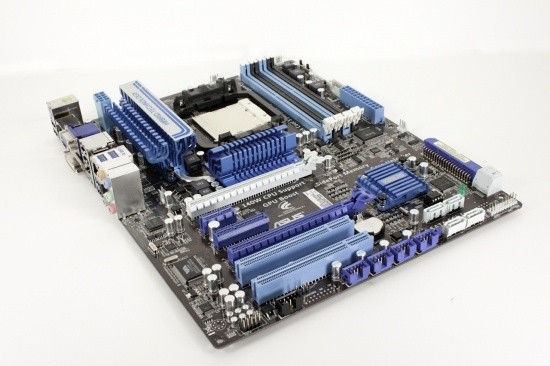
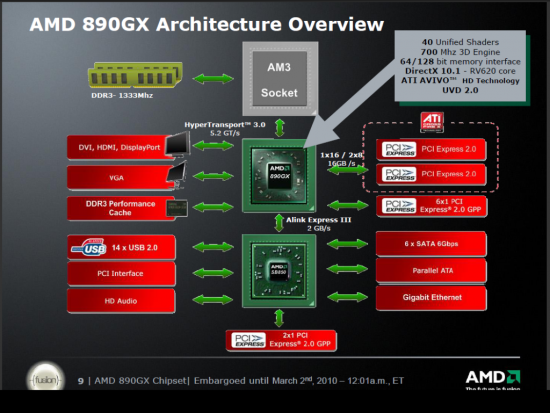

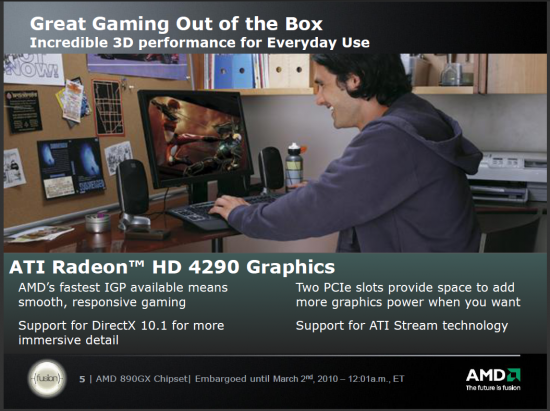

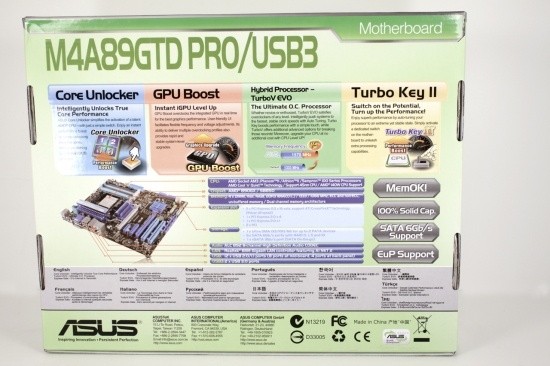

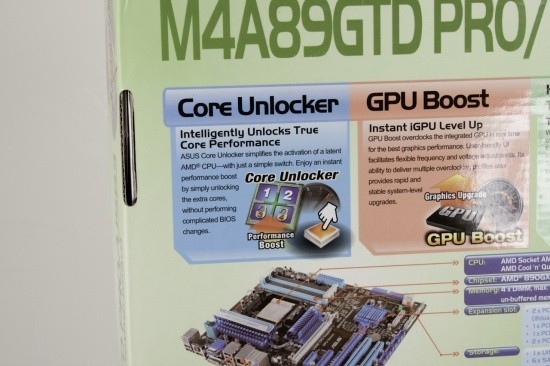


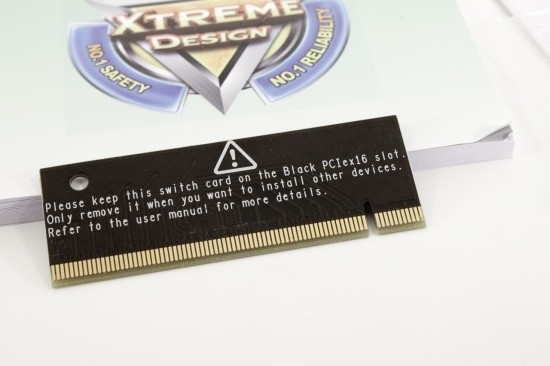
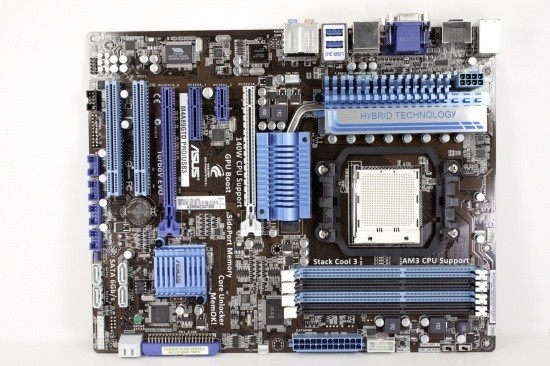

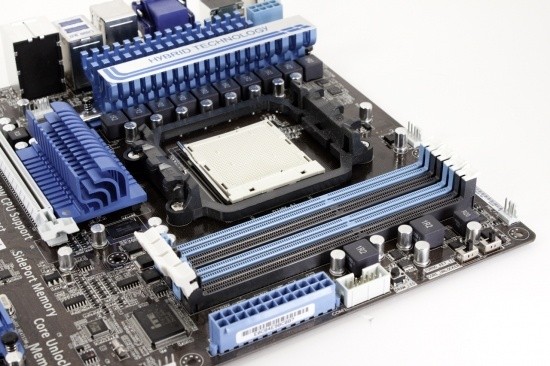
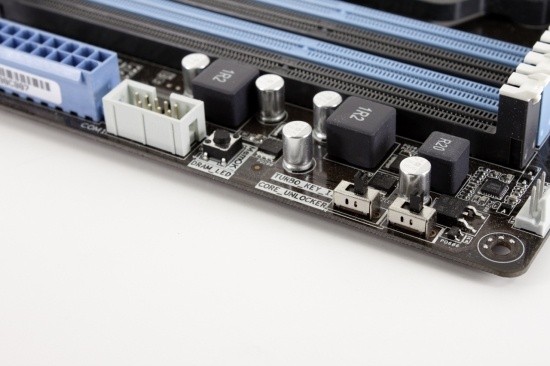

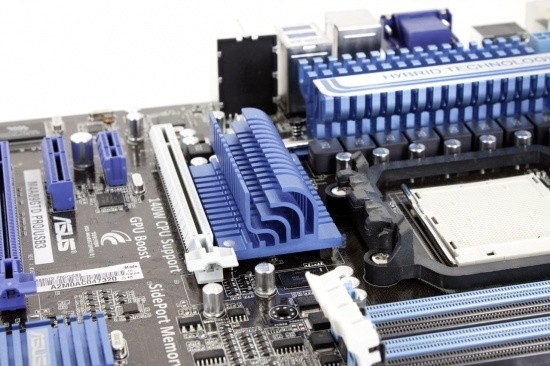
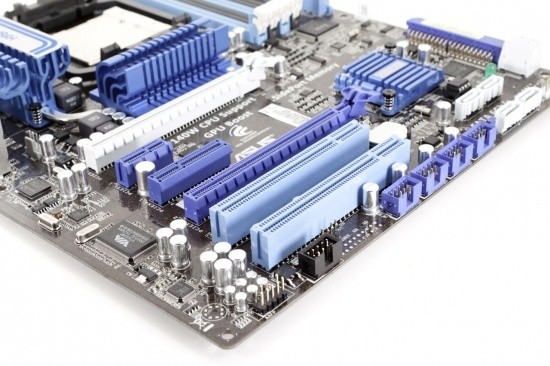
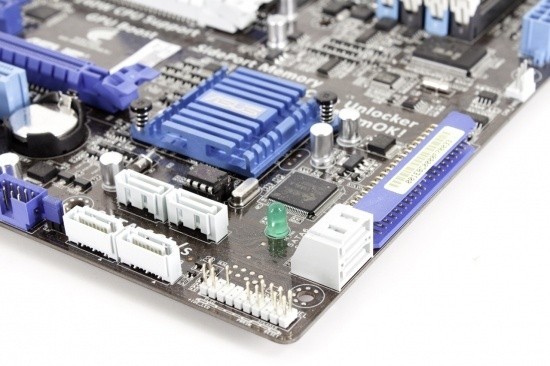

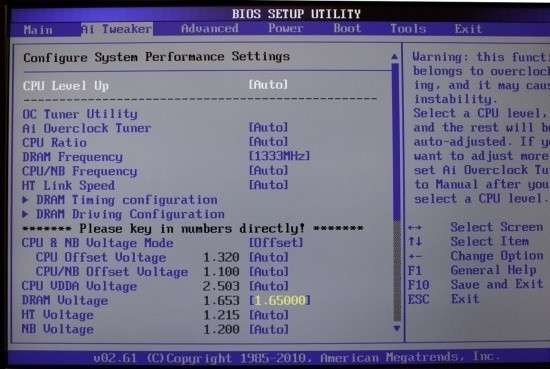

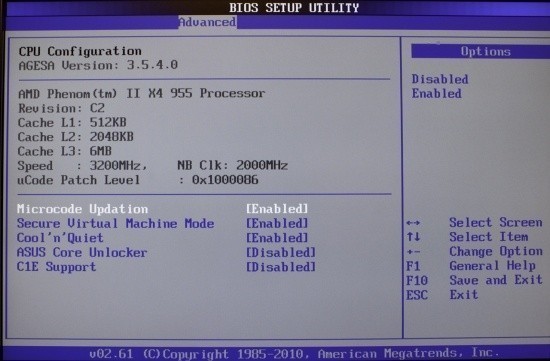


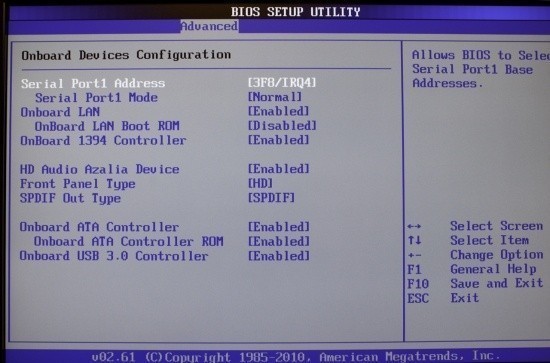

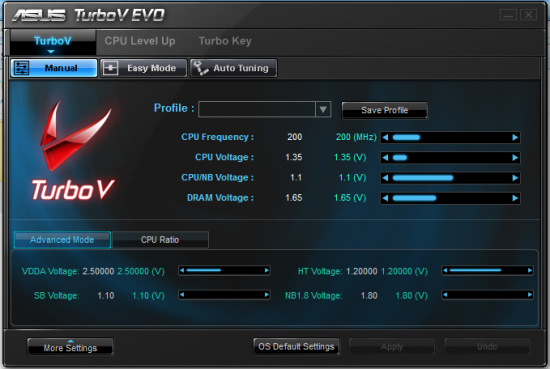

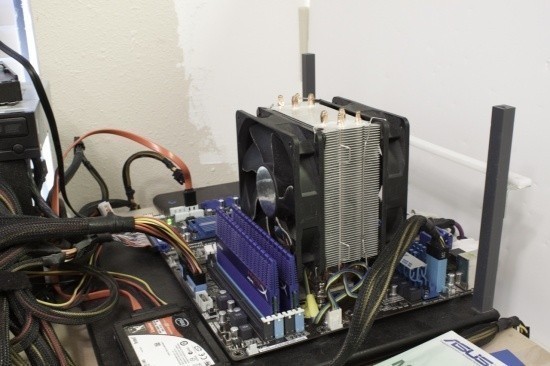



















 United
States: Find other tech and computer products like this
over at
United
States: Find other tech and computer products like this
over at  United
Kingdom: Find other tech and computer products like this
over at
United
Kingdom: Find other tech and computer products like this
over at  Australia:
Find other tech and computer products like this over at
Australia:
Find other tech and computer products like this over at  Canada:
Find other tech and computer products like this over at
Canada:
Find other tech and computer products like this over at  Deutschland:
Finde andere Technik- und Computerprodukte wie dieses auf
Deutschland:
Finde andere Technik- und Computerprodukte wie dieses auf